Charles Hamilton Mitchell, CB, CMG, DSO, civil engineer and military intelligence officer (born 18 February 1872 in Petrolia, ON; died 26 August 1941 in Toronto, ON). Charles Hamilton Mitchell was an engineer and intelligence officer in the Canadian Expeditionary Force in the First World War and attained the rank of brigadier general. He served in England, France and Italy during the war and became the most decorated intelligence officer in Canadian military intelligence history. After the war, he became dean of engineering at the University of Toronto, serving in that role until 1941.

Early Life and Education
Charles Hamilton Mitchell was born to George Mitchell and Agnes Beckett in February 1872 in Petrolia, Ontario. His father, George Mitchell, was a minister and a graduate of the University of Toronto. Mitchell attended the School of Practical Science at the University of Toronto and studied civil engineering. He graduated in 1894 and qualified as a civil engineer in 1898.
After university, Hamilton specialized in hydro-electric power projects. He first worked as the assistant city engineer in Niagara Falls and later was promoted to the post of city engineer. In 1906, he left Niagara and set up a consulting firm in Toronto with his brother Percival, focusing on hydroelectric power plant construction. His firm designed and built several power plants throughout Canada. In 1901, Mitchell married Myra Ethlyn Stanton.
Military Service
Charles Mitchell initially joined the militia in 1899 and served in the 44th Lincoln and Welland Regiment as well as the Corps of Guides, formed in 1903 and the precursor of the Canadian Intelligence Corps created in 1942. Upon the outbreak of the First World War, Mitchell joined the Canadian Expeditionary Force (CEF) and was appointed General Staff Officer 3rd Grade — a captain’s position — on staff of Headquarters, 1st Canadian Division. When the Canadian Corps was formed in August 1915, Mitchell was sent to its headquarters as General Staff Officer 2nd Grade (Intelligence) — a major’s assignment — and the senior Intelligence appointment in the CEF. He therefore played an important role in establishing a Corps intelligence organization. He had no Canadian precedent to guide him, although he could call on his experience in 1st Division and on the considerable help he received from his British counterparts.
In September 1916, Mitchell became the head of the Intelligence Branch of Second British Army as a colonel; in October 1918, he was promoted to brigadier general and served as a senior intelligence officer in the War Office in London. By the end of the war, he had been decorated by the British, French, Belgian and Italian governments. He was appointed to the Order of the Bath on 3 June 1918, while serving on the headquarters of the General Staff of the British Army in Italy with the CEF. He remains the most decorated intelligence officer in Canadian military history.

Dean of Engineering
After the war, Charles Mitchell was appointed dean of the Faculty of Applied Science at the University of Toronto. Mitchell’s military service and reputation were a benefit in his new role, as a large proportion of the student population were veterans. Mitchell oversaw the faculty during the interwar period, during which the student body grew significantly. New academic programs were added, including engineering physics, and mining geology.
Mitchell had other roles outside the university. In 1924, he worked with Americans on the Joint Board of Engineers to conduct preliminary studies on the St. Lawrence waterway. He also served on the boards of the Toronto Civic Guild, the Toronto Symphony Orchestra, the local board of trade and the Toronto Centennial Committee, which celebrated 100 years of the city of Toronto in 1934. Mitchell retired from his role at the university in 1941, shortly before his death on 26 August 1941.
Military Honours and Awards
- Mentioned in Dispatches (1916, 1916, 1917, 1917, 1918, 1918, 1919, 1919)
- Distinguished Service Order (1916)
- Officer of the Legion of Honour (France) (1916)
- Companion of the Order of St Michael and St George (1917)
- Officer of the Order of Leopold (Belgium) (1917)
- Croix de Guerre (Belgium) (1918)
- Officer of the Order of the Crown (Italy) (1918)
- Companion of the Order of Bath (1918)
- War Merit Cross (Italy) (1919)

 Share on Facebook
Share on Facebook Share on X
Share on X Share by Email
Share by Email Share on Google Classroom
Share on Google Classroom










